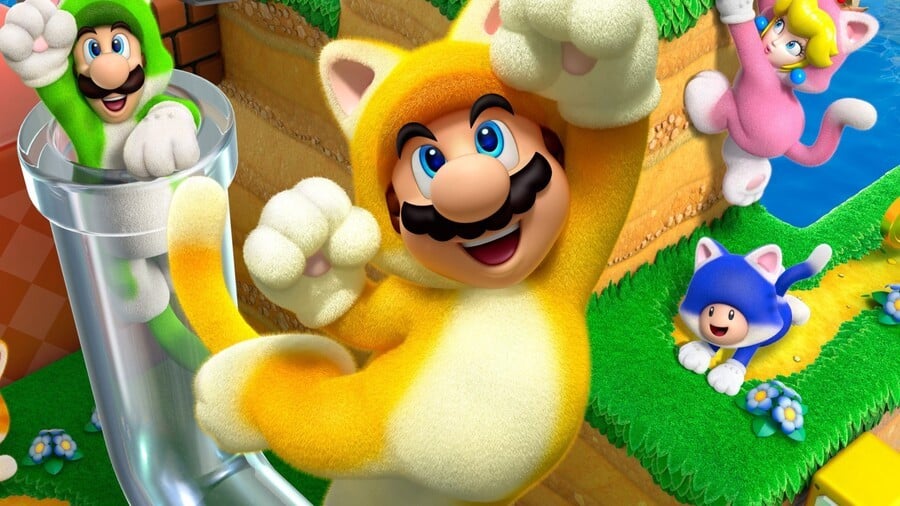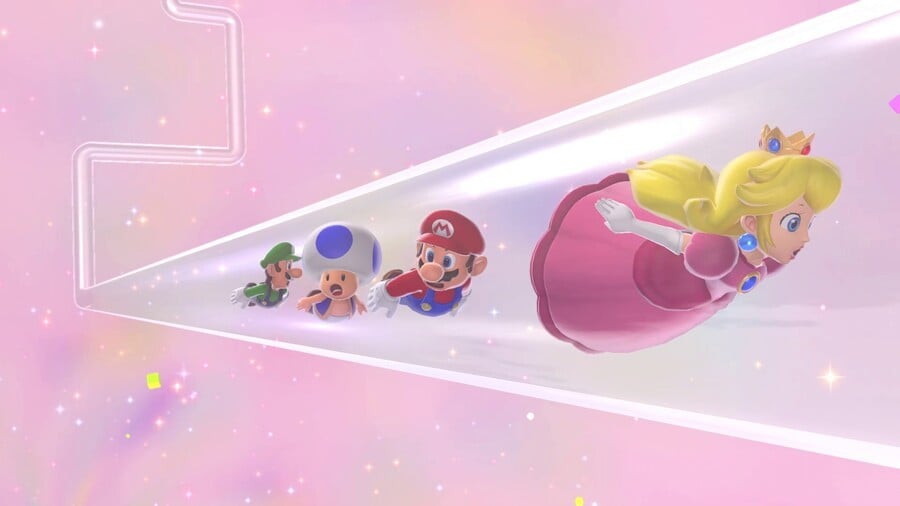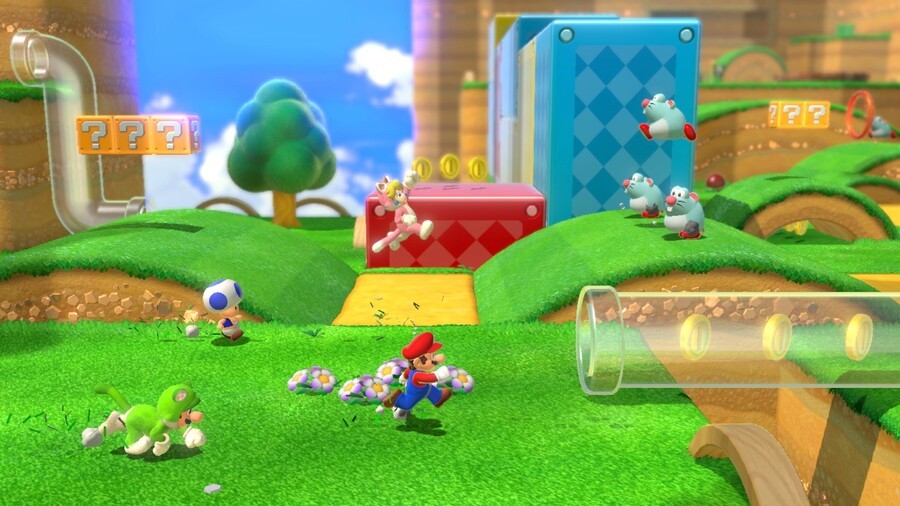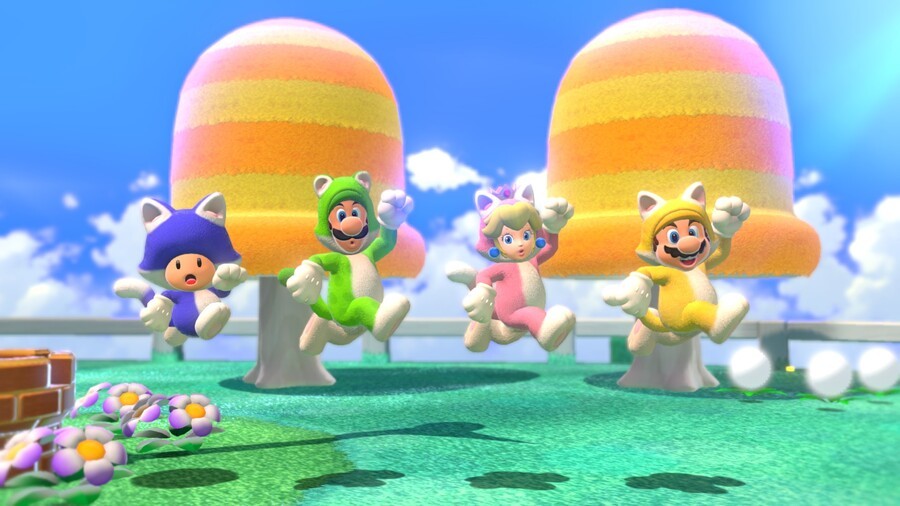Soapbox: Super Mario 3D World Is The Closest To A Super Mario Bros. 2 Sequel We’ll Ever Get
Soapbox features enable our individual writers to voice their own opinions on hot games, trends and topics — opinions that may not necessarily be the voice of the site. In this piece, Jon Irwin discusses how Nintendo seems reluctant to return to the mechanics of Super Mario Bros. 2…
When Super Mario 3D World first released for the Wii U in 2013, the world was a very different place. Brexit was years away, Donald Trump was just another reality TV host, and Nintendo had its back against the wall in a way it never had since entering the video game industry. The year prior it had lost money for the first time in its modern history.
Perhaps it was this urgency, then, that made the company finally attempt what it had neglected to do for twenty-five years: make a follow-up to Super Mario Bros. 2.
Well, not exactly. Super Mario 3D World was the Wii U pseudo-sequel to Super Mario 3D Land on the 3DS — even the creators themselves say so. “To be upfront about it, ever since we started developing Super Mario 3D Land, we thought about making Super Mario 3D World in continuation afterward,” said Koichi Hayashida of what was then known as EAD Tokyo, the studio tasked with making 3D Mario games.
But more than in any Mario game in the intervening years, 3D World borrows major elements from Mario 2 on the NES, including the ability to choose four different characters, each with their own abilities. Luigi flutters his legs and jumps higher. Peach hovers in air for a few extra tics. Toad runs the fastest. There are bonus stages that mirror the post-level slot machine of SMB2, with an arrangement of that very same song. If you progress far enough, a rocket propels you skyward to the next collection of stages; the spaceship is modeled exactly on the Rocketship found in SMB2. And though you can’t pluck turnips out of the ground, special stages star a ground-bound “Captain” Toad who would go on to pluck and toss the veggies in his very own starring title heavily based on the 3D World levels, Captain Toad: Treasure Tracker.
In a way, this is nothing new: Nintendo ‘poaching’ from Nintendo is a long-held philosophy. But then why hadn’t the core conceit of Super Mario Bros. 2 — four unique characters, pulling and throwing instead of jumping and stomping — ever been re-used? Mario games comprise an extended timeline of iteration; from game to game to game, an incessant series of minor tweaks transform old ideas into seemingly new things altogether, the way a river turns rocks into polished stones. 3D World could be seen as the culmination of this thinking. Kenta Motokura, co-director on the game, had a simple policy: “Let’s put everything in!” So perhaps it’s unsurprising that so many aspects of Mario 2 bubbled up to the surface during 3D World’s development.
why hadn’t the core conceit of Super Mario Bros. 2 — four unique characters, pulling and throwing instead of jumping and stomping — ever been re-used?
Mario 2 itself is merely an adjustment of a previous concept. As any reader of this site no doubt knows, the Super Mario Bros. 2 we got in the West is a reskinned and modified version of the Japanese game Yume Kōjō: Doki Doki Panic from one year prior. That it took a quarter-century for another Mario game to lift SMB2’s core tenet is remarkable; when seen with the clarifying hindsight of over thirty years, the most surprising thing about Mario 2 isn’t that it was a success — which it undoubtedly was, selling over seven million copies — but that a game retooled entirely for the North American market has infiltrated and influenced the entirety of Mario’s output ever since.
Elements first witnessed in the NES sequel crop up everywhere the plumber does, from Birdo’s inclusion in Mario Tennis to Shy Guys driving karts in Mario Kart 7. (The masked introverts are even the default racer when playing a two-player match using Download Only play… but perhaps this is a sign of their low cachet.) Mario’s second Super outing even adorned the very first cover of the company’s official magazine in the West, cementing his status as not a flash in the pan but a turnip-throwing hero to be reckoned with for decades to come. Except he never did throw them again.
Other Mario sequels and spin-offs evolved into entire series of their own: Super Mario Land 2 on the Game Boy featured a new villain named Wario who would go on to star in his own platforming series before turning to more nefarious schemes involving microgames and making money. Super Mario Kart, of course, turned into the system-selling behemoth we know today. Even Mario Teaches Typing got a direct follow-up.
The closest thing to a Mario 2 sequel was the eReader levels for the Game Boy Advance port of Super Mario Bros.3, which dropped in SMB2 gameplay elements like turnips into the classic SMB3 layouts. Not exactly a high-profile release. And big boss Wart? Relegated to a Super Smash Bros. trophy.
Nintendo’s reluctance to tap into the core of Mario 2 is an odd and beguiling omission. The company has a talent for expertly mining nostalgia for cold hard cash, yet they have ignored a beloved entry that catapulted their flagship franchise into the stratosphere in the West. Other one-off features from classic entries have become mainstays: Yoshi is rideable in games from Super Mario Sunshine to New Super Mario Bros. U, while flight power-ups have returned time and again in various guises since SMB3’s raccoon tail. But the simple ability to pluck an item from the ground and throw it — so instrumental to Mario 2’s identity, yet so mundane an action as to be obvious and expected — has remained off-limits.
Beyond the veggie-plucking mechanic, Mario 2’s four playable characters have also been ignored for curious reasons. Even when New Super Mario Bros. Wii added the ability to play with four people at the same time, Nintendo punted on bringing back Mario 2’s roster. Director of NSMBU Masataka Takemoto explained they wanted each character to feel the same. For a company that values the constant improvement of endless iteration, that answer never felt satisfying. When Super Mario 3D World finally brought back the classic characters and their signature skill set, it brought with it twenty-five years of design knowledge, advancing technology, and a trademark dose of nostalgia.
Director Motokura joined Nintendo in 2000 and was a child when Super Mario Bros. 2, re-released in Japan as Super Mario USA, came out. “The fact that I was raised playing Mario games in my childhood had a big impact on how I make games,” he told The Guardian last year.
Playing 3D World again in anticipation of the Switch version reminds me how similar it feels to the 1988 NES game, at least in spirit. In the first level of Super Mario Bros. 2, you fall from a door in the sky with little explanation. During 3D World’s opening cinematic, you watch as Mario and company get transported through clear pipes to some unknown land. In both cases the gang is far from the Mushroom Kingdom.
Playing 3D World again in anticipation of the Switch version reminds me how similar it feels to the 1988 NES game, at least in spirit.
Each game plays with verticality in similar ways. Whereas the original Super Mario Bros. had the occasional secret vine waiting to transport you to a cloud platform, Mario 2 had you constantly climbing up or digging down to access new areas. 3D World furthers that style with its Cat Suit power-up, giving each player the ability to climb up walls and reach new heights. Another new power-up, the Double Cherry, also feels plucked directly from Mario 2, where they provided in-level health and extra lives during the slot machine bonus game. Between 1988 and 2013, no other Mario game featured cherries in any significant way.
Now, over seven years later, Super Mario 3D World + Bowser’s Fury gives Switch owners a chance to experience the closest thing to a Mario 2 sequel we’ll likely ever get. Maybe Nintendo was right not to dip its toes back into Sub-con’s waters for so long. In the intervening years since 3D World’s original launch, the world has crumbled. A pandemic rages. Global alliances have fractured. Our political systems are stressed to the point of breaking. Perhaps Nintendo knew the Mario 2 formula was special, or tainted, a broken thing that never meant to exist and would unlock something horrible if revisited. Was it all worth it for another chance to float down on Peach’s parasol? Has Captain Toad throwing a turnip clutched from the earth dulled our collective pain?
Or maybe the resultant chaos emerged only because of their ‘half-hearted’ effort back in 2013. Our only hope is that the 2021 release completes what they never finished. Bowser’s Fury, a new standalone section exclusive to the Switch port, looks to be a compelling chapter in Mario’s forever war against King Koopa. And though Wart is nowhere to be seen, I can’t help but see this side-story as a nod to Mario 2 and its dream factory, but twisted into something else entirely: a nightmare.
Might Mario wake up at the end of Bowser’s Fury, the way he did in 1988? We could all use a fresh start. Let us hope he, and the rest of us, find closure and a way to move forward. Even if we never again return to Sub-con.
If you’re a lover of Super Mario Bros. 2 on the NES, Jon’s book on that very subject may be of interest.





